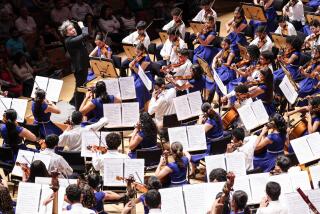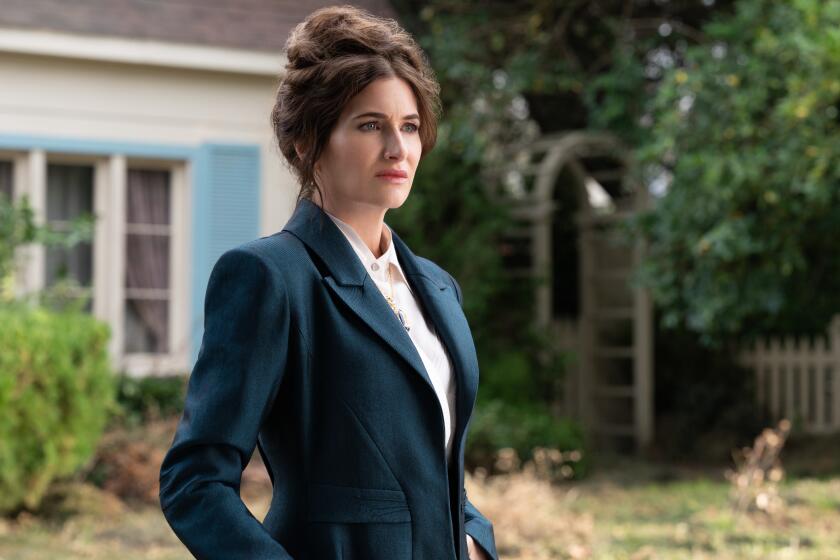In Mozart’s spirit
Vienna — “WELCOME to Vienna and this special edition of ‘Alternative Radio,’ ” the MC proclaims to an eager late-night crowd in the hip concert space of Austrian Radio. Jimi Hendrix’s freak-out version of “The Star-Spangled Banner” blasts through the loudspeakers, more raucously distorted than ever. The lights go crazy.
America has never heard anything like this, the MC enthusiastically announces. America, in fact, has -- the Hendrix “arrangement” is a longtime specialty of the Kronos Quartet, which was on the ORF stage. But Vienna is another story.
It’s Saturday night in the city. Just past 11. The ornamental historic concert halls and opera houses have emptied out. Does anyone know where Mozart is?
Vienna’s yearlong celebration of Mozart’s 250th birthday is winding down. Mozart tourism has peaked. And the New Crowned Hope Festival -- which opened last week with several Kronos concerts, the premiere of a new opera by John Adams, new films from the Middle East, a major new video work by Bill Viola and other art installations -- isn’t intended, exactly, to help move the Amadeus kitsch off the schlock-shop shelves.
Vienna has entrusted Peter Sellars, the festival’s director, with creating a four-week event within the official Mozart Year 2006 festivities and has given him a budget of nearly $13 million with which to do so. The opera and theater director, who has previously created festivals in Los Angeles and Adelaide, Australia, that were more ambitious than those cities could accept, has now been allowed to think on the scale he has always wanted. And, as before, he has thought globally and controversially.
New Crowned Hope was the name of the Masonic lodge in the outskirts of Vienna, to which Mozart belonged in his final year. The intent of the festival is to begin where Mozart left off when he died here in 1791, deeply in debt, politically out of favor, a radical, visionary artist who imagined a better, just society and was buried in a pauper’s grave among the forgotten poor. Sellars has brought in new work in art, architecture, film, music, opera, dance, theater and literature, much of it specially commissioned. But he has also made community development, refugee work, organic farming and food factors in the festival.
Many of the artists involved are his well-known American or European collaborators. Adams’ five previous music theater works were directed by Sellars, as was his new opera, “A Flowering Tree,” which opened the festival. Kaija Saariaho’s two operas were directed by Sellars and her next staged work, “La Passion de Simone,” a co-commission with the Los Angeles Philharmonic, will have its premiere Sunday. Next month, Mark Morris brings his “Mozart Dances” (the only Mozart to be heard in the festival). Artist Viola (with whom Sellars collaborated on “The Tristan Project” at Walt Disney Concert Hall) has created “Bodies of Light,” a spiritually profound 25-minute video of light emanating from a female and a male body, and images from it are on large posters around town.
But the overall impression of New Crowned Hope is that of a vision beyond the West. Much of the music, dance and film (five have been commissioned) is non-Western, an acknowledgment that Vienna, for all its Old Europe feel, is vibrantly, if uneasily, multicultural. The capital has long stood as a crossroads for East and West. It has long been and continues to be a magnet for refugees.
Consequently, Vienna has provided the most extravagant and cogent opportunity for Sellars to put to use art as social action, which made for a very intense weekend. It included the Kronos’ two-part “Alternative Radio” presentation on Saturday afternoon and late evening, in which the American historian and prominent antiwar spokesman Howard Zinn was interviewed by the radio broadcaster David Barsamian.
Zinn uses the examples from history to seek new solutions for peace; the Kronos uses the music of the world. One attacked the intellect, the other the heart. I thought the heart was better served. A melody from Iraq, played with love, does not tell us how to end the conflict, but why.
Wu Man, the exceptional Chinese pipa player, added elegance to the afternoon colloquy. In the wee hours, an Inuit singer like no other, Tanya Tagaq, made sounds with her voice, resonating into each quartet player’s instrument, full of longing and ecstasy, the revelation of a life force that goes beyond explanation.
Sunday afternoon, Kronos and Wu Man played music from Iran, Sweden, Iceland, Iraq, China, India, Mexico and America for about 200 asylum seekers in a camp in the town of Traiskirchen, about 20 miles south of Vienna. It is a sad place, a way station for refugees from 44 countries. Many will not be allowed to stay and will have no place to go.
No concert had ever been presented in the camp, which was created 50 years ago, and no one knew what to expect. Most who attended in a community room with rows of wooden benches were restless young men, but there were also mothers and children. Some listened and were visibly moved. Many more, though, seemed glad for a social occasion. The room became electric when the music was upbeat, the crowd spontaneously clapping. During slow, mournful numbers, many preferred not to listen.
Ultimately, I felt the concert was for the children. Toys were used as part of a lullaby in Terry Riley’s “The Cusp of Magic.” While the audience quickly filed out after the concert, the children rushed to the stage to try out the toys. Their eyes were bright. Their sense of rhythm ebullient. They played freely with children from other cultures. They, it was clear, provided a new crowned hope. No one knows what will happen to them.
“A Flowering Tree,” in its last performance that evening, was the hope made radiantly joyful. A modest music-theater piece for three singers, chorus and orchestra, it is on the scale of “El Nino.” In that work, Adams created a modern response to Handel’s “Messiah.” “A Flowering Tree” is his response to Mozart’s “The Magic Flute.”
Adams and Sellars fashioned a libretto from texts by Attipat Krishnaswami Ramanujan, which tell the 2,000-year-old fable from South India in which a young girl, who has the ability to turn into a flowering tree, is sabotaged by a jealous sister of the prince who marries her. She becomes half tree and half woman, lost to the prince and a refugee from humanity. In grief, the prince turns beggar. But the couple is ultimately reunited, and the tree becomes, once more, a beautiful girl.
Staged by Sellars, the opera is a riot of color and fervently multicultural. The orchestra, made up of students and teachers from Venezuela, remained on stage and in flamboyant native costumes. The chorus, the exciting Schola Cantorum de Venezuela, sang in Spanish. The cast featured a storyteller (Eric Owens, who was Grendel in the Los Angeles Opera production last spring), and the lovers (Jessica Rivera and Russell Thomas). Three exquisite Indonesian dancers enacted much of the action. At key moments, dancers, soloists and chorus all intertwined movingly.
Adams’ score contains a considerable amount of rhythmically infectious music, and the choral writing is spectacular. Recorders were added to the wind section, and Indonesian instruments to the percussion. But joy is not a regular part of modern European music. Nor is such unembarrassed beauty. European critics were hard on the opera, but the audience was in love with it.
Some things need improving, and they will get it. The spirit and swagger of the orchestra couldn’t quite outweigh its playing. Adams conducted with more vigor and directness than finesse. But next month, the Berlin Philharmonic will perform it in concert under Simon Rattle. The San Francisco Symphony will play it in concert in March. The Los Angeles Philharmonic has committed to it sometime in the near future.
If New Crowned Hope offered no more than this new work, it could count itself a musical success. The bigger goal of changing hearts and minds of Vienna, however, remains.
*
More to Read
The biggest entertainment stories
Get our big stories about Hollywood, film, television, music, arts, culture and more right in your inbox as soon as they publish.
You may occasionally receive promotional content from the Los Angeles Times.











